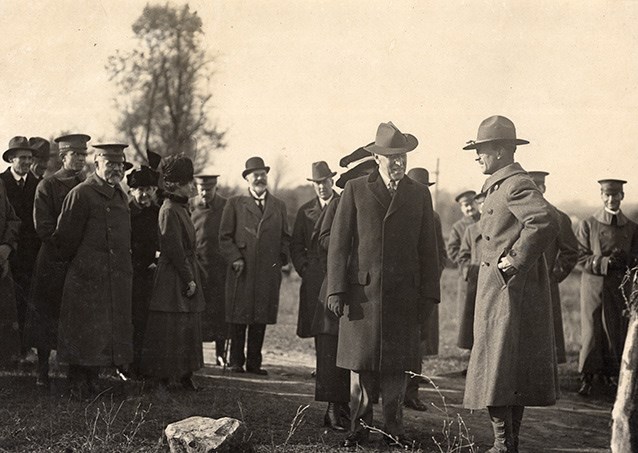Last updated: August 18, 2023
Article
The War of Deception: Artists and Camouflage in World War I

U.S.Army Signal Corps, 1917; in the collections of Saint-Gaudens National Historic Site
Camouflage was first developed in France in 1914 by artist Lucien-Victor Guirand de Scévola and others. The theatrical nature of the subject encouraged artists to participate in the attempts to hide military personnel and actions. The British followed, with the Americans coming later.
In the United States, this development took place a few years later, using the talents of the artists of the Cornish Colony in Cornish, New Hampshire, at the site of the present-day Saint-Gaudens National Historical Park.The painters George DeForest Brush, Barry Faulkner, and Abbott Thayer all worked to persuade the military to adopt principles of coloration to mask ships, weapons and troops. Thayer published Concealing Coloration in the Animal Kingdom (1909) in which he described countershading (darker color on top, lighter below) in the animal world. His son Gerald applied the theory to military camouflage. George DeForest Brush and his wife Mary Taylor Brush, joined later by their son Gerome, urged the navy to adapt coloration and patterns to camouflage ships. Barry Faulkner and Harry Thrasher were part of the initial American response to the war, developing elaborate cloaking techniques that proved too cumbersome for actual warfare. Although not fully documented, Thrasher is credited with devising an artificial horse carcass to be placed next to a ruined weapons caisson. A scout or sniper could hide inside the horse unseen. Beginning with natural camouflage and theatrical deception, as time went by the technique was organized into specific patterns.
While these Cornish artists worked to bring their talents to the aid of America’s war effort, the son of the sculptor Augustus Saint-Gaudens, the young Homer Saint-Gaudens (1880-1958), joined the camouflage unit of the Engineers. Homer was raised in an atmosphere of art, but was not an artist himself. After attending Harvard, he worked as a theatrical producer and writer before finding his career in Pittsburgh at the Carnegie Institute. Trained in Plattsburgh, New York in 1917, he soon made a name for himself. During training he reused surplus coats from the Civil War to provide new material for uniforms. As a young Second Lieutenant of Engineers in France in 1918, he saw the shortage of cotton for blankets and recycled paper to make new cloth. The patterns on the paper made a kind of camouflage which would be enhanced by dyeing with green, brown or grey color. At first simple blankets were made of the material that could be dragged along by a sniper or scout on the ground, hiding underneath. Later the paper was used on buildings or weapons.
Promoted to Captain, Saint-Gaudens was put in charge of the Camouflage Section of the Second Army in October, 1918. Several of his artist friends from Cornish served with him, including Barry Faulkner and Harry Thrasher. Both contributed to the development of camouflage, Faulkner in organization, and Thrasher as a soldier on the line, testing out the concepts in real-life situations. Thrasher would be a casualty, killed just as the Armistice was being signed. Barry Faulkner found his friend, and had the sad duty of writing home to his family.
For Homer Saint-Gaudens this was a long-time commitment. In the Second World War he was in charge of camouflage for domestic and military purposes, serving as a full Colonel at D-Day, among other assignments. He was in charge of organizing effective camouflage for American factories and other important civil infrastructure such as roads and bridges. For this he received a Bronze Star and was decorated by France and other nations.
